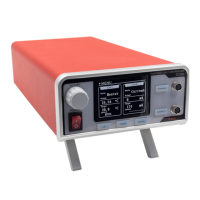TC300 Heater Temperature Controller Chapter 6: Stand-Alone Operation
Page 18 CTN017856-D02
The manual tuning of the PID gains is usually a trial-and-error process and heavily dependent on the thermal
response of the entire heating system. There is no optimum approach. Below is a suggested approach that should
give users a good starting point.
1. Make sure the heater and the sensor are both correctly connected to the TC300 and the heat load. Ensure
that the TC300 is correctly configured with the correct sensor type, proper current/voltage limit and
temperature range.
2. Connect the corresponding analog output port on the back panel to an oscilloscope as a way of observing
the temperature change.
3. Set the I and D shares to minimum and the P share to very low.
4. Enable the channel, and gradually increase the P share value. Observe the temperature on the
oscilloscope. Increase the P value to a point where the temperature just starts to oscillate. Depending on the
properties of the heating system, the oscillation period could vary from seconds to tens of minutes.
5. Tune the I share to bring the error between the set temperature and the center of the oscillation to minimum.
6. Tune the D share so that the system stops oscillating.
7. Change the set temperature by ±1 °C, fine tune the I share and D share so that the system could reach
the new temperature with a minimum number of overshoots.
6.7. Single/Dual Channel Operation
The TC300 temperature controller is set to single channel operation by default. To enable dual channel operation,
go to the option menu, move the cursor to “Channels”, press the “ENTER” button to confirm selection and then turn
the knob or press “UP” and “DOWN” to toggle between single and dual channel operation. Press “ENTER” again
to validate the setting.
Figure 25 Toggling Between Single Channel and Dual Channel Operation
When dual channel operation is enabled, users can copy all configurations of CH1 to CH2, by moving the cursor to
“Copy CH1 to CH2” and pressing the “ENTER” button. The operation will copy every setting of CH1 including
operation mode, sensor type, and parameters, current/voltage limit, temperature range and PID gains. The enabling
and disabling of channels remains independent.
Figure 26 Copy all CH1 Configurations to CH1

